|
|
|||||||||
|
PROJECTS & EXHIBITIONS - ARCHIVE |
|||||||||
|
Opening February 12, 2011, BoxoFFICE gallery will feature work by artist Eric Rhein. The exhibit will run February 12 thru April 9, 2011. Eric Rhein, a native of New York's Hudson Valley, and resident of Manhattan, is known for his refined and passionate wire drawings which combine human forms with animal and plant life. He weaves personal stories, experiences, and mysticism into explorations of the powerful connections among man, nature, and the spiritual world. Rhein's own photographs (often taken on Fire Island), as well as vintage photography of male nudes, are combined with found objects, as well as bronze & silver castings of Leaves & twigs. These assemblages, like Rhein's other works, depict a sense of humanity's communion with nature, and evoke figures from Celtic and Egyptian mythology.
Visual Aids will be hosting a special event during the exhibit on April 9th, in celebration of Rhein's new body of work. www.visualaids.org
Hours: Saturdays 1-6PM, and by appointment BoxoFFICE
November 7 to December 21, 2006 Leslie/Lohman Gay Art Foundation "Eric Rhein's life experiences manifest themselves in a body of work in which pleasure flirts
with mystery and danger. His phallic sculptures wrought from wire; the exoskeletal figures, looking
like suits of armor; the virile half-men-half-creatures – all afford intimate glimpses into his
intriguing private mythology. In the East Village studio in which he works, Rhein creates assemblages of beads,
crystals, bottle caps, gears and other bits of detritus; pages from books, often the blank endpapers, and pieces
of jewelry. Like the syllables in a haiku, they are assembled into delicate but stirring compositions, often
deceptively simple in their appearance but charged with the big universal themes." JOURNEY AMONG WARRIORS Leslie/Lohman Gay Art Foundation, 26 Wooster Street, New York, NY 10013
Uncle Lige's Sword, an art exhibition by Eric Rhein
With the precision of a jeweler, Rhein creates delicate constructions from wire, paper, and found objects, weaving personal stories and experiences into intricate patterns. Using nature as metaphor, Rhein evokes a transcendental universe and celebrates the resilient potential of the body and spirit. Integrating leaves, birds, animals, and human figures, he explores the delicate and powerful connections among humans, nature, and the spiritual world, and suggests the metamorphoses inherent in relationships and experiences. Sculptures, which incorporate pages from medical textbooks, suggest illuminated manuscripts in three dimensional form, and draw a correlation between the AIDS epidemic and the Black Plague of the Middle Ages. Works from The Leaf Project, which Rhein conceived in 1996 to pay tribute to friends who had died of complications from AIDS, anchor the exhibition with recognition of the magnitude of loss during the height of the epidemic.
Based in Manhattan, Eric Rhein has been exhibiting his sculptures and wire drawings for over 20 years in New York, elsewhere in the U.S., and in London, Paris, Munich, Stockholm, and Tokyo. Publications that have reviewed and/or reproduced his artwork include Art in America, Interview, the New York Times, Village Voice, Metrosource, POZ, the James White Review, Dutch Elle, and Vanity Fair. Rhein holds an MFA from the School of Visual Arts. He has received grants from the Pollock/Krasner Foundation, Adolph and Esther Gottlieb, and Art Matters. The exhibit runs Monday, September 25, 2006 through Sunday, December 10, 2006, with an opening Reception, Tuesday, September 26, 2006 from 6 - 8 pm. Admission is free. Viewing Daily 10am - 5:30pm. Call the Center for evening viewing hours. The Center is located at 208 West 13th Street, between 7th and 8th Avenues. Subway: 1,2,3, L,F,V to 14th Street & 7th Avenue. A,C, E, L to 14th Street & 8th Avenue. UNCLE LIGE'S SWORD A tribute to Elijah "Lige" Clarke, noted gay rights pioneer, by his nephew, New York artist Eric Rhein, who has been greatly influenced by his uncle's activism to include themes about HIV and AIDS in his artwork. Elijah "Lige" Clarke, 1942-1975: U.S. Army Private with top security clearance, assigned to the Army's Chief of Staff at the Pentagon; an organizer of the first gay rights picket line at the White House in 1965; founding editor, with his partner Jack Nichols, of GAY, America's first nationwide weekly gay newspaper (1969-1973), which sounded the first call to arms following the Stonewall uprising; founding member of the Washington Mattachine Society; Hatha Yoga teacher; inexplicably ambushed, shot and killed near Vera Cruz, Mexico.
Uncle Lige's picture with arms outspread, gracing the book Welcome to Fire Island, 1976, (a book he was writing at the time of his death, and which Jack finished), seemed a greeting to me. It welcomed me to the place where I would spend summers creating wire drawings of nude men, fantastical morphed creatures, and nature. Although HIV and AIDS weren't part of Uncle Lige's life, at the height of the epidemic I wondered what it would have been like for him to see our world swept by plague. I realize that it is through his mentoring that I have included themes about HIV and AIDS in the context of my artwork as a form of activism. My memorial, The Leaf Project, which pays tribute to those I've known who died of complications from AIDS, includes some of my uncle's friends whom I'd met over the years. It was Jack Nichols who drew the correlation between The Leaf Project and lines from Walt Whitman (Uncle Lige's favorite poet), in "These I Singing in Spring," from Leaves of Grass, in which the poet encounters the spirits of friends: "As I ponder Eric Rhein's art, Walt Whitman's poem [...] surfaces. The great American poet saunters 'far, far in the forest' and before he can think where he is going, he finds himself 'solitary, smelling the earthy smell, stopping now and then in the silence.' At first the poet thought himself alone. But wait! he says. 'Alone I had thought, yet soon a troop gathers around me. Some walk by my side and some behind and some embrace my arms or neck. They the spirit of dear friends dead or alive, thicker they come, a great crowd, and I in the middle [...]'" |
|||||||||
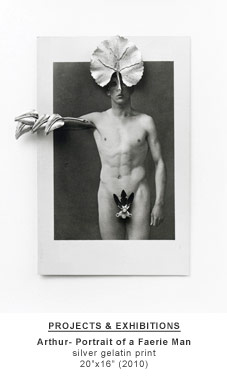

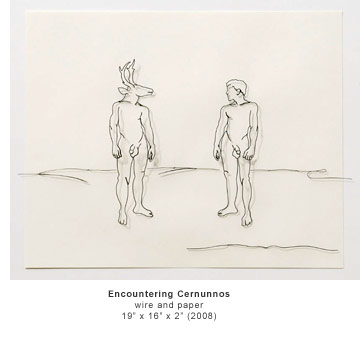
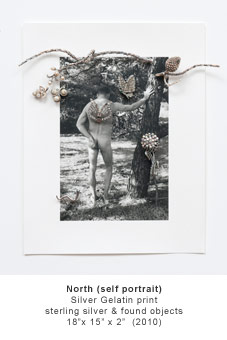
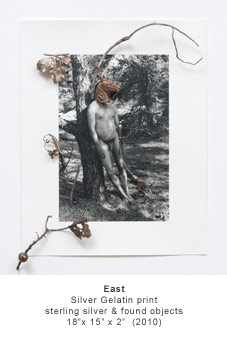
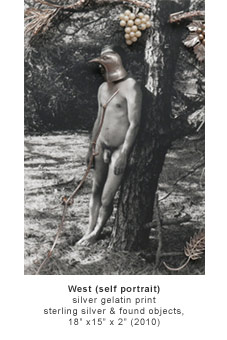
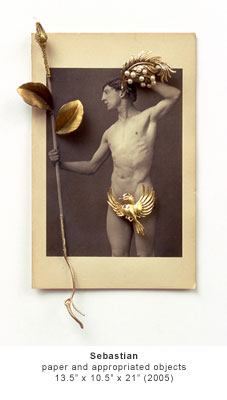
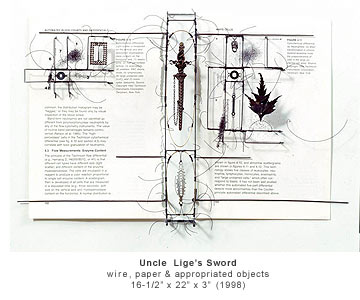
 With the title Uncle Lige's Sword, Rhein dedicates this exhibition to the memory of his uncle Lige (Elijah) Clarke, a pioneer,
along with his lover Jack Nichols, in the Gay Rights movement of the late 1960s through the early 70s. The sword is used as a
metaphor for Clarke's courage and indomitable spirit. Rhein draws a correlation between Clarke's crusade for gay rights and his
own activism by including themes about HIV and AIDS in his body of work.
With the title Uncle Lige's Sword, Rhein dedicates this exhibition to the memory of his uncle Lige (Elijah) Clarke, a pioneer,
along with his lover Jack Nichols, in the Gay Rights movement of the late 1960s through the early 70s. The sword is used as a
metaphor for Clarke's courage and indomitable spirit. Rhein draws a correlation between Clarke's crusade for gay rights and his
own activism by including themes about HIV and AIDS in his body of work.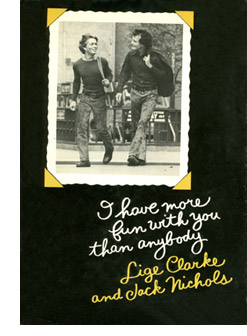 At the threshold of puberty, when I overheard a conversation between Uncle Lige and my mother discussing his sexuality, my intuition
that he was gay was confirmed. I later found the books that he and Jack had written on gay male relationships, (I Have More Fun With
You Than Anybody, 1972, and Roommates Can't Always Be Lovers: An Intimate Guide to Male-Male Relationships, 1974) in my mother's cedar
chest. Much of my aspirations, aesthetics, and spirituality were heavily influenced by my nighttime readings of their books.
At the threshold of puberty, when I overheard a conversation between Uncle Lige and my mother discussing his sexuality, my intuition
that he was gay was confirmed. I later found the books that he and Jack had written on gay male relationships, (I Have More Fun With
You Than Anybody, 1972, and Roommates Can't Always Be Lovers: An Intimate Guide to Male-Male Relationships, 1974) in my mother's cedar
chest. Much of my aspirations, aesthetics, and spirituality were heavily influenced by my nighttime readings of their books.